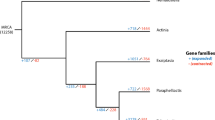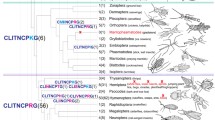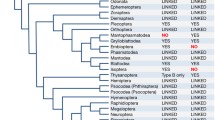Abstract
Sea anemones are sessile predators that use a variety of toxins to paralyze prey and foe. Among these toxins, Types I, II and III are short peptides that affect voltage-gated sodium channels. Anemonia viridis is the only sea anemone species that produces both Types I and III neurotoxin. Although the two toxin types are unrelated in sequence and three-dimensional structure, cloning and comparative analysis of their loci revealed a highly similar sequence at the 5′ region, which encodes a signal peptide. This similarity was likely generated by gene fusion and could be advantageous in transcript stability and intracellular trafficking and secretion. In addition, these analyses identified the processed pseudogenes of the two gene families in the genome of A. viridis, probably resulting from retrotransposition events. As presence of processed pseudogenes in the genome requires transcription in germ-line cells, we analyzed oocyte-rich ovaries and found that indeed they contain Types I and III transcripts. This result raises questions regarding the role of toxin transcripts in these tissues. Overall, the retrotransposition and gene fusion events suggest that the genes of both Types I and III neurotoxins evolved in a similar fashion and share a partial common ancestry.




Similar content being viewed by others
References
Altschul SF, Madden TL, Schaffer AA, Zhang J, Zhang Z, Miller W, Lipman DJ (1997) Gapped BLAST and PSI-BLAST: a new generation of protein database search programs. Nucleic Acids Res 25:3389–3402
Anderluh G, Podlesek Z, Macek P (2000) A common motif in proparts of Cnidarian toxins and nematocyst collagens and its putative role. Biochem Biophys Acta 1476:372–376
Beress L, Beress R, Wunderer G (1975) Isolation and characterization of three polypeptides with neurotoxic activity from Anemonia sulcata. FEBS Lett 50:311–314
Betran E, Thornton K, Long M (2002) Retroposed new genes out of the X in Drosophila. Genome Res 12:1854–1859
Bosch TCG, David CN (1987) Stem cells of Hydra magnipapillata can differentiate into somatic cells and germ line cells. Dev Biol 121:182–191
D’errico I, Gadaleta G, Saccone C (2004) Pseudogenes in metazoa: origin and features. Brief Funct Genomic Proteomic 3:157–167
Dellacorte C (1994) Isolation of nucleic acids from the sea anemone Condylactis gigantea (Cnidaria: Anthozoa). Tissue Cell 26:613–619
Ding W, Lin L, Chen B, Dai J (2006) L1 elements, processed pseudogenes and retrogenes in mammalian genomes. IUBMB Life 58:677–685
Duda TF Jr, Palumbi SR (1999) Molecular genetics of ecological diversification: duplication and rapid evolution of toxin genes of the venomous gastropod Conus. Proc Natl Acad Sci USA 96:6820–6823
Edgar RC (2004) MUSCLE: multiple sequence alignment with high accuracy and high throughput. Nucleic Acids Res 32:1792–1797
Favreau P, Menin L, Michalet S, Perret F, Cheneval O, Stocklin M, Bulet P, Stocklin R (2006) Mass spectrometry strategies for venom mapping and peptide sequencing from crude venoms: case applications with single arthropod specimen. Toxicon 47:676–687
Fox JW, Serrano SM (2008) Exploring snake venom proteomes: multifaceted analyses for complex toxin mixtures. Proteomics 8:909–920
Genikhovich G, Kürn U, Hemmrich G, Bosch TC (2006) Discovery of genes expressed in Hydra embryogenesis. Dev Biol 289:466–481
Hartung K, Rathmayer W (1985) Anemonia sulcata toxins modify activation and inactivation of Na+ currents in a crayfish neurone. Pflugers Arch 404:119–125
Honma T, Shiomi K (2006) Peptide toxins in sea anemones: structural and functional aspects. Mar Biotechnol 8:1–10
Korbel JO, Urban AE, Affourtit JP, Godwin B, Grubert F, Simons JF, Kim PM, Palejev D, Carriero NJ, Du L et al (2007) Paired-end mapping reveals extensive structural variation in the human genome. Science 318:420–426
Kozlov SA, Grishin EV (2007) The universal algorithm of maturation for secretory and excretory protein precursors. Toxicon 49:721–726
Liao Z, Cao J, Li S, Yan X, Hu W, He Q, Chen J, Tang J, Xie J, Liang S (2007) Proteomic and peptidomic analysis of the venom from Chinese tarantula Chilobrachys jingzhao. Proteomics 7:1892–1907
Liu WH, Wang L, Wang YL, Peng LS, Wu WY, Peng WL, Jiang XY, Tu HB, Chen HP, Ou-Yang P et al (2003) Cloning and characterization of a novel neurotoxin from the sea anemone Anthopleura sp. Toxicon 41:793–801
Long M (2000) A new function evolved from gene fusion. Genome Res 10:1655–1657
Manoleras N, Norton RS (1994) Three-dimensional structure in solution of neurotoxin III from the sea anemone Anemonia sulcata. Biochemistry 33:11051–11061
Martin DP, Williamson C, Posada D (2005) RDP2: recombination detection and analysis from sequence alignments. Bioinformatics 21:260–262
Miljkovic-Licina M, Gauchat D, Galliot B (2004) Neuronal evolution: analysis of regulatory genes in a first-evolved nervous system, the hydra nervous system. Biosystems 76:75–87
Moran Y, Gurevitz M (2006) When positive selection of neurotoxin genes is missing. The riddle of the sea anemone Nematostella vectensis. FEBS J 273:3886–3892
Moran Y, Cohen L, Kahn R, Karbat I, Gordon D, Gurevitz M (2006) Expression and mutagenesis of the sea anemone toxin Av2 reveals key amino acid residues important for activity on voltage-gated sodium channels. Biochemistry 45:8864–8873
Moran Y, Kahn R, Cohen L, Gur M, Karbat I, Gordon D, Gurevitz M (2007) Molecular analysis of the sea anemone toxin Av3 reveals selectivity to insects and demonstrates the heterogeneity of receptor site-3 on voltage-gated Na-channels. Biochem J 406:41–48
Moran Y, Weinberger H, Sullivan JC, Reitzel AM, Finnerty JR, Gurevitz M (2008a) Concerted evolution of sea anemone neurotoxin genes is revealed through analysis of the Nematostella vectensis genome. Mol Biol Evol 25:737–747
Moran Y, Weinberger H, Reitzel AM, Sullivan JC, Kahn R, Gordon D, Finnerty JR, Gurevitz M (2008b) Intron retention as a posttranscriptional regulatory mechanism of neurotoxin expression at early life stages of the starlet anemone Nematostella vectensis. J Mol Biol 380:437–443
Nakashima K, Ogawa T, Oda N, Hattori M, Sakaki Y, Kihara H, Ohno M (1993) Accelerated evolution of Trimeresurus flavoviridis venom gland phospholipase A2 isozymes. Proc Natl Acad Sci USA 90:5964–5968
Nei M, Rooney AP (2005) Concerted and birth-and-death evolution of multigene families. Annu Rev Genet 39:121–152
Pahari S, Mackessy SP, Kini RM (2007) The venom gland transcriptome of the Desert Massasauga rattlesnake (Sistrurus catenatus edwardsii): towards an understanding of venom composition among advanced snakes (Superfamily Colubroidea). BMC Mol Biol 8:115
Pâques F, Haber JE (1999) Multiple pathways of recombination induced by double-strand breaks in Saccharomyces cerevisiae. Microbiol Mol Biol Rev 63:349–404
Putnam NH, Srivastava M, Hellsten U, Dirks B, Chapman J, Salamov A, Terry A, Shapiro H, Lindquist E, Kapitonov VV et al (2007) Sea anemone genome reveals ancestral eumetazoan gene repertoire and genomic organization. Science 317:86–94
Richier S, Rodriguez-Lanetty M, Schnitzler CE, Weis VM (2008) Response of the symbiotic cnidarian Anthopleura elegantissima transcriptome to temperature and UV increase. Comp Biochem Physiol D 3:283–289
Sakaguchi M (1997) Eukaryotic protein secretion. Curr Opin Biotechnol 8:595–601
Sakai H, Koyanagi KO, Imanishi T, Itoh T, Gojobori T (2007) Frequent emergence and functional resurrection of processed pseudogenes in the human and mouse genomes. Gene 389:196–203
Sawyer SA (1989) Statistical tests for detecting gene conversion. Mol Biol Evol 6:526–538
Schacherer J, Tourette Y, Souciet JL, Potier S, De Montigny J (2004) Recovery of a function involving gene duplication by retroposition in Saccharomyces cerevisiae. Genome Res 14:1291–1297
Shichor I, Zlotkin E, Ilan N, Chikashvili D, Stuhmer W, Gordon D, Lotan I (2002) Domain 2 of Drosophila para voltage-gated sodium channel confers insect properties to a rat brain channel. J Neurosci 22:4364–4371
Siebert PD, Chenchik A, Kellogg DE, Lukyanov KA, Lukyanov SA (1995) An improved PCR method for walking in uncloned genomic DNA. Nucleic Acids Res 23:1087–1088
St. Pierre L, Earl ST, Filippovich I, Sorokina N, Masci PP, De Jersey J, Lavin MF (2008) Common evolution of waprin and kunitz-like toxin families in Australian venomous snakes. Cell Mol Life Sci 65:4039–4054
Sullivan JC, Ryan JF, Watson JA, Webb J, Mullikin JC, Rokhsar D, Finnerty JR (2006) Stellabase: the Nematostella vectensis genomic database. Nucleic Acids Res 34:D495–D499
Tamura K, Dudley J, Nei M, Kumar S (2007) MEGA4: Molecular Evolutionary Genetics Analysis (MEGA) software version 4.0. Mol Biol Evol 24:1596–1599
Vinckebosch N, Dupanloup I, Kaessmann H (2006) Evolutionary fate of retroposed gene copies in the human genome. Proc Natl Acad Sci USA 103:3220–3225
Wedi SE, Dunn DF (1983) Gametogenesis and reproductive periodicity of the subtidal sea anemone Urticina Lofotensis (Coelenterata: Actinaria) in California. Biol Bull 165:458–472
Yuan D, Nakanishi N, Jacobs DK, Hartenstein V (2008) Embryonic development and metamorphosis of the scyphozoan Aurelia. Dev Genes Evol 218:525–539
Zhu S, Bosmans F, Tytgat J (2004) Adaptive evolution of scorpion sodium channel toxins. J Mol Evol 58:145–153
Acknowledgment
The research was supported by the United States-Israel Binational Agricultural Research and Development Grant IS-3928-06 (M.G. and D.G.), and by the Israeli Science Foundation grants 1008/05 (D.G. and M.G.).
Author information
Authors and Affiliations
Corresponding authors
Additional information
Sequence data from this article have been deposited with the GenBank Data Libraries under accession numbers EU919727–EU919736.
Electronic supplementary material
Below is the link to the electronic supplementary material.
Rights and permissions
About this article
Cite this article
Moran, Y., Weinberger, H., Lazarus, N. et al. Fusion and Retrotransposition Events in the Evolution of the Sea Anemone Anemonia viridis Neurotoxin Genes. J Mol Evol 69, 115–124 (2009). https://doi.org/10.1007/s00239-009-9258-x
Received:
Revised:
Accepted:
Published:
Issue Date:
DOI: https://doi.org/10.1007/s00239-009-9258-x




